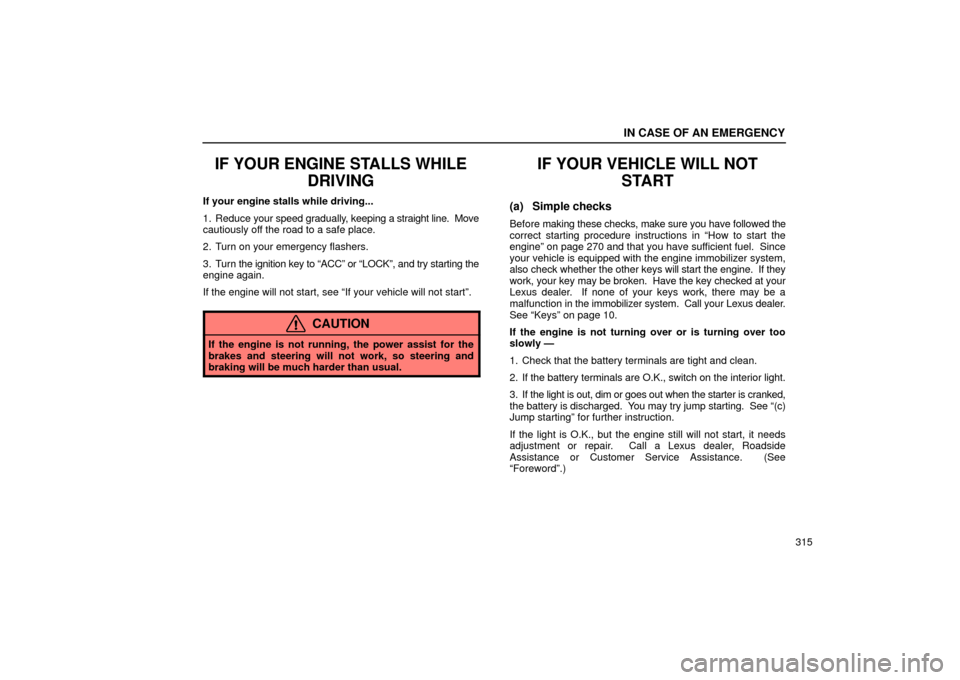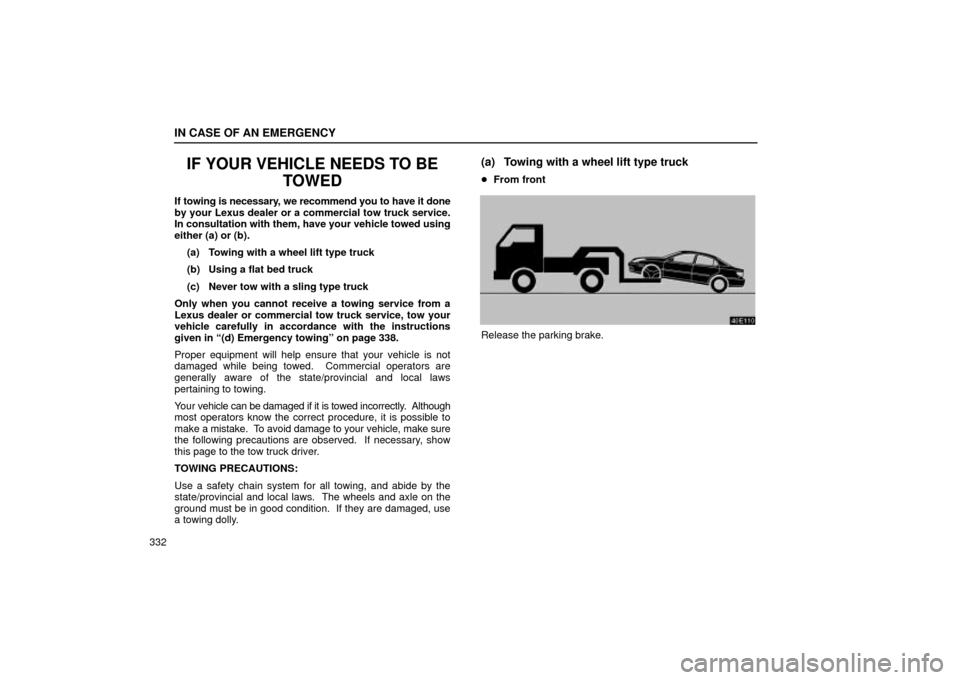Page 331 of 482

DRIVING TIPS
306�Avoid jerky starts or sudden acceleration.
�Avoid jerky steering and sharp turns. The trailer could hit
your vehicle in a tight turn. Slow down before making a turn
to avoid the need of sudden braking.
�Remember that when making a turn, the trailer wheels will
be closer than the vehicle wheels to the inside of the turn.
Therefore, compensate for this by making a larger than
normal turning radius with your vehicle.
�Crosswinds and rough roads will adversely affect handling
of your vehicle and trailer, causing sway. Pay attention to
the rear from time to time to prepare yourself for being
passed by large trucks or buses, which may cause your
vehicle and trailer to sway. If swaying happens, firmly grip
the steering wheel and reduce speed immediately but
gradually. Never increase speed. If it is necessary to
reduce speed, brake slowly. Steer straight ahead. If you
make no extreme correction with the steering or brakes,
your vehicle and trailer will stabilize.
�Be careful when passing other vehicles. Passing requires
considerable distance. After passing a vehicle, do not forget
the length of your trailer and be sure you have plenty of room
before changing lanes.
�In order to maintain efficient engine braking and electrical
charging performance, do not use overdrive.�Because of the added load of the trailer, your vehicle's
engine may overheat on hot days (at temperatures over
30�C [85�F]) when going up a long or steep grade with a
trailer. If the engine coolant temperature gauge indicates
overheating, immediately turn off the air conditioning (if in
use), pull your vehicle off the road and stop in a safe spot.
See If your vehicle overheatsº on page 321.
�Always place wheel blocks under both the vehicle and trailer
wheels when parking. Apply the parking brake firmly. Put
the transmission in Pº. Avoid parking on a slope with a
trailer, but if it cannot be avoided, do so only after performing
the following:
1. Apply the brakes and keep them applied.
2. Have someone place wheel blocks under both the vehicle
and trailer wheels.
3. When the wheel blocks are in place, release your brakes
slowly until the blocks absorb the load.
4. Apply the parking brake firmly.
5. Shift into Pº and turn off the engine.
When restarting out after parking on a slope:
1. With the transmission in Pº position, start the engine. Be
sure to keep the brake pedal depressed.
2. Shift into the 3º, 2º, Lº or Rº position.
Page 332 of 482

DRIVING TIPS
307 3. Release the parking brake and brake pedal and slowly pull
or back away from the wheel blocks. Stop and apply your
brakes.
4. Have someone retrieve the blocks.
CAUTION
�Do not exceed 72 km/h (45 mph) or the posted towing
speed limit, whichever is lower. Because instability
(swaying) of a towing vehicle-trailer combination
usually increases as the speed increases, exceeding
72 km/h (45 mph) may cause loss of control.
�Slow down and downshift before descending steep
or long downhill grades. Do not make sudden
downshifts.
�Avoid holding the brake pedal down too long or too
frequently. This could cause the brakes to overheat
and result in reduced braking efficiency.
HOW TO SAVE FUEL AND MAKE
YOUR VEHICLE LAST LONGER
Improving fuel economy is easy Ð just take it easy. It will help
make your vehicle last longer, too. Here are some specific tips
on how to save money on both fuel and repairs:
�Keep your tires inflated at the correct pressure. Check
the pressure every two weeks, or at least once a month.
Underinflation causes tire wear and wastes fuel.
�Do not carry unneeded weight in your vehicle. Excess
weight puts a heavier load on the engine, causing greater
fuel consumption.
�Avoid lengthy warm-up idling. Once the engine is
running smoothly, begin driving Ð but gently. Remember,
however, that on cold winter days this may take a little
longer.
�Always drive with the automatic transmission selector
lever in the Dº position when engine braking is not
required. Driving with the overdrive off will reduce the fuel
economy. (For details, see Automatic transmissionº on
page 272.)
�Accelerate slowly and smoothly. Avoid jackrabbit starts.
�Avoid long engine idling. If you have a long wait and you
are not in traffic, it is better to turn off the engine and start
again later.
Page 336 of 482
DRIVING TIPS
311
6. If your vehicle will be towing a trailer, load from your
trailer will be transferred to your vehicle. Consult this
manual to determine how this reduces the available
cargo and luggage load capacity of your vehicle.
For details about trailer towing, see page 300.Example on your vehicle
�1Cargo capacity
2Total load capacity
In case that 2 people with the combined weight of
166 kg (366 lb.) are riding in your vehicle with the
total load capacity of 410 kg (900 lb.), the available
amount of cargo and luggage load capacity will be
as follows:
410 kg ± 166 kg = 244 kg.
(900 lb. ± 366 lb. = 534 lb.)
From this condition, if 3 more passengers with the
combined weight of 176 kg (388 lb.) get on, the
available cargo and luggage load will be reduced as
follows:
244 kg ± 176 kg = 68 kg.
(534 lb. ± 388 lb. = 146 lb.)
Page 337 of 482
DRIVING TIPS
312
As shown in the above example, if the number of
occupants increases, the cargo and luggage load
equaling the combined weight of occupants who got
on later must be reduced. In other words, if the
increase in the number of occupants causes the
excess of the total load capacity (combined weight
of occupants plus cargo and luggage load), you have
to reduce the cargo and luggage on your vehicle.
For details about total load capacity, see Vehicle load
limitsº on page 309.
CAUTION
Even if the total load of occupant's weight and
the cargo load is less than the total load
capacity, do not apply the load unevenly. That
may cause not only damage to the tire but also
deterioration to the steering ability due to
unbalance of the vehicle, causing an accident.
Page 340 of 482

IN CASE OF AN EMERGENCY
315
IF YOUR ENGINE STALLS WHILE
DRIVING
If your engine stalls while driving...
1. Reduce your speed gradually, keeping a straight line. Move
cautiously off the road to a safe place.
2. Turn on your emergency flashers.
3. Turn the ignition key to ACCº or LOCKº, and try starting the
engine again.
If the engine will not start, see If your vehicle will not startº.
CAUTION
If the engine is not running, the power assist for the
brakes and steering will not work, so steering and
braking will be much harder than usual.
IF YOUR VEHICLE WILL NOT
START
(a) Simple checks
Before making these checks, make sure you have followed the
correct starting procedure instructions in How to start the
engineº on page 270 and that you have sufficient fuel. Since
your vehicle is equipped with the engine immobilizer system,
also check whether the other keys will start the engine. If they
work, your key may be broken. Have the key checked at your
Lexus dealer. If none of your keys work, there may be a
malfunction in the immobilizer system. Call your Lexus dealer.
See Keysº on page 10.
If the engine is not turning over or is turning over too
slowly Ð
1. Check that the battery terminals are tight and clean.
2. If the battery terminals are O.K., switch on the interior light.
3. If the light is out, dim or goes out when the starter is cranked,
the battery is discharged. You may try jump starting. See (c)
Jump startingº for further instruction.
If the light is O.K., but the engine still will not start, it needs
adjustment or repair. Call a Lexus dealer, Roadside
Assistance or Customer Service Assistance. (See
Forewordº.)
Page 355 of 482
IN CASE OF AN EMERGENCY
330
IF YOUR VEHICLE BECOMES
STUCK
If your vehicle becomes stuck in snow, mud, sand, etc.,
then you may attempt to rock the vehicle free by moving
it forward and backward.Vehicles with traction control system Ð Turn off the
traction control system to become unstuck to allow the
tires to spin enough to remove the vehicle from the
obstruction. (For details, see Traction control systemº
on page 283.)
CAUTION
Do not attempt to rock the vehicle free by moving it
forward and backward if people or objects are anywhere
near the vehicle. During the rocking operation the
vehicle may suddenly move forward or backward as it
becomes unstuck, causing injury or damage to nearby
people or objects.
Page 357 of 482

IN CASE OF AN EMERGENCY
332
IF YOUR VEHICLE NEEDS TO BE
TOWED
If towing is necessary, we recommend you to have it done
by your Lexus dealer or a commercial tow truck service.
In consultation with them, have your vehicle towed using
either (a) or (b).
(a) Towing with a wheel lift type truck
(b) Using a flat bed truck
(c) Never tow with a sling type truck
Only when you cannot receive a towing service from a
Lexus dealer or commercial tow truck service, tow your
vehicle carefully in accordance with the instructions
given in (d) Emergency towingº on page 338.
Proper equipment will help ensure that your vehicle is not
damaged while being towed. Commercial operators are
generally aware of the state/provincial and local laws
pertaining to towing.
Your vehicle can be damaged if it is towed incorrectly. Although
most operators know the correct procedure, it is possible to
make a mistake. To avoid damage to your vehicle, make sure
the following precautions are observed. If necessary, show
this page to the tow truck driver.
TOWING PRECAUTIONS:
Use a safety chain system for all towing, and abide by the
state/provincial and local laws. The wheels and axle on the
ground must be in good condition. If they are damaged, use
a towing dolly.
(a) Towing with a wheel lift type truck
�From front
Release the parking brake.
Page 363 of 482
IN CASE OF AN EMERGENCY
338
(d) Emergency towingIf towing is necessary, we recommend you to have it done
by your Lexus dealer or a commercial tow truck service.
If towing service is not available in an emergency, your
vehicle may be temporarily towed by a cable or chain
secured to the emergency towing eyelet. Use extreme
caution when towing the vehicle.
To install the front towing eyelet, see (e) Installing front towing
eyeletº on page 339.
NOTICE
�Only use specified towing eyelet; otherwise your
vehicle may be damaged.
�Never tow a vehicle from the rear with four wheels on
the ground. This may cause serious damage to the
transmission.